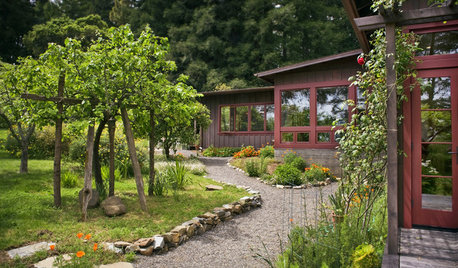I tried to resurrect an old thread about green figs but didn't seem to be successful. So I'm starting a new one. (Yes, I'm fig obsessed. I've been anxiously to get my hands on fresh figs ever since my grandparents had to sell their house about 15 years ago and we lost access to their huge fig tree. I really should knock on the door and see if the current owners pick them.)
I've been picking my neighbors figs but I've had to start picking them a day or two before they are fully ripe or I lose them to the animals - raccoons, I suspect, based on the bite marks and the fact that we see them. There are some bird pecks as well. (Even then they get almost half of them.) So far I've been making preserves or jam with them. I make little batches and throw them in the fridge. So far I've made, 1 3/4 jars, 2 1/2 jars, 1 jar, 1 jar, and a tart.
Anyway, out of curiosity, I wondered if anyone else has tried anything like this.
http://mamastaverna.com/baby-fig-spoon-sweet-sikalaki-gliko/
(From the old thread) I copied this from the web site linked to above. If some of it seems disjointed, its because there were photos in between, which were referred to in the text and which didn't copy:
Baby Fig Spoon Sweet (Sikalaki Gliko)
Mama makes her traditional recipes from memory, but when memory needs a little boost, she hauls out her battered old copy of Megali Mageiriki. The classic Greek cookbook, its very 1950Âs, complete with faded photos of fancy but unappetizing-looking food. Remember those old Betty Crocker cookbooks? ItÂs like that. Nevertheless, it has great recipes, probably because traditional Greek cooking predates the fifties by a few centuries or so.
With ZoeÂs help, IÂve translated a recipe for candied baby figs from Megali Mageiriki . It uses unripe figs, and the great thing about unripe figs is that the birds wonÂt have eaten them before you can pick them. Once the figs on the tree are ripe, theyÂre pretty much lost to me, but (ha-ha!) now I can outwit the birds. Sort of.
The recipe didnÂt specify what size the unripe figs should be, so I picked a variety of sizes, as you can see below.
The large one on the left is a full-grown fig that just hasnÂt ripened yet. Frankly, the figs of this size turned out nasty and I threw them away. All the others turned out great. My favorites are the medium sized ones shown in the center. I like them because theyÂve started to make seeds, and the seeds add a pleasantly contrasting crunch to an otherwise soft consistency.
Ingredients
2 pounds unripe figs
3 pounds sugar
3 cups water
lemon juice (a couple of tablespoons)
cloves and/or vanilla (just guess!)
Rinse the figs and poke a hole in each fig with a thick nail. This step will be a bit messy from the sticky latex oozing out of the figs.
I do actually know the difference between a nail and a screwdriver. I found that a small phillips screwdriver works just as well and is easier to handle.
Okay, once youÂre done poking the figs, put them in water and let them soak for a few hours.
Next, boil the figs in plain water for 15 minutes.
When the 15 minutes are done, put the figs into cold water, then when theyÂre cool, drain them.
Dump the old water out of your cookpot, and and replace it with fresh water. Repeat the sequence of boiling the figs for 15 minutes, putting them in cold water until theyÂre cool, and then draining them.
Boil the 3 pounds of sugar with the 3 cups of water for about 5 minutes, then add the figs.
Boil the figs in the syrup for 15 minutes, then turn the heat off.
Leave the figs in the syrup for 12 hours.
Remove the figs from the syrup and boil the syrup until it is thick.
Put the figs back in, along with the lemon juice, cloves, and vanilla.
Boil a few more minutes until the syrup is again well-thickened.
Put into clean jars and store.
Warning! The pot and colander you use will end up with sticky little smears of latex all over them. I had to scrub it off with scouring powder. I tend to think the latex would even defeat nonstick cookware and would be very difficult to remove without abrasives, so I suggest sticking with cookware that you can give a good scrubbing to.
* Posted by denninmi 6A (My Page) on
Sun, Oct 19, 08 at 22:10
I made the candied figs today. Last night, I cut slits in each fig, and soaked over night in water. This seemed to remove the latex most effectively -- the soaking water was very milky. I had NO latex residue in my pot after boiling for 30 minutes total in the 2 changes of water.
Anyway, I made an interesting observation after I had boiled the figs the 2nd time -- they smelled and TASTED almost EXACTLY like green beans, although the flavor wasn't too pronounced. So, I think, at this stage, they really could be pickled using a green bean recipe, if someone wanted to.
But, having gone that far, I was committed to the original Greek recipe, so I finished them tonight (after letting them sit all day in the sugar syrup). Flavored with lemon, cloves, and vanilla, they turned out quite nice. I used both lemon zest and lemon juice, from two lemons, and this made it very flavorful. I also boiled the syrup down quite a bit thicker than it seemed to be in the original recipe. For storage, I've packed into pint containers and am going to freeze them. The two pounds of figs filled about 4 pint sized freezer containers.
These are definitely something I would do again with figs that otherwise are just going to go to waste due to non-ripening.
Green Fig Preserve
From Jellies, Jams & Chutneys, by Thane Prince
This recipe comes from the traditional cuisine of the Western Cape region of South Africa and makes wonderful use of green - that is unripe figs. When cooked, the fruits turn a deep translucent bottle-green. Serve with thinly sliced white bread, or with desserts.
Takes up to 2 1/4 hours, make 2 1/4 lb (1 kg), keeps for 6 months
3 1/2 oz (100g) salt
2 1/4 lb 91 kg) unripe green figs, stems intact
1 tsp baking soda
for the syrup
3 1/2 lb (1 kg) granulated sugar
4 in (10cm) piece of fresh ginger, lightly crushed
1. In a large glass or china bowl, dissolve the salt in 8 cups water to make the brine.
2. Cut a small cross in the base of each fig and scrape the skins if they are very fuzzy. Put the prepared figs in the brine and let sit for 24 hours.
3. Drain the figs and rinse under cold running water. Put in a non-reactive saucepan, cover with water, and add the baking soda. Bring to a boil and simmer for 10-15 minutes until the figs are just tender. Drain.
4. Meanwhile make the syrup. Put the sugar and 1 1/4 cups water in a non-reactive pot and bring to a boil. Add the ginger. Simmer for about 5 minutes until the syrup thickens slightly.
5. Lift the figs into the syrup and simmer gently or low heat for 1 to 2 hours until the figs are translucent.
6. Drain the figs, reserving the syrup. Pack into sterilized jars and cover with the syrup, discarding the ginger. Seal and label.
Fig Konfyt (Preserved Green Figs)
from Preserving, by Oded Schwartz (also originally published in the UK) (I've never made anything from this book but love looking at it.)
This recipe comes from South Africa, where making rich preserves has been developed into a fine art. The figs should be fully mature but not ripe, otherwise they will not withstand the cooking process.
2 lb (1 kg) green, unripe figs
4 tablespoons salt
1 tablespoon baking soda (optional)
4 cups (1 kg) granulated sugar
1/2 cup water
1. Trim the stem end off each fig, then, with a small sharp knife, cut a deep cross into the top.
2. Place the figs in a large glass bowl. Cover with cold water and add the salt. Mix well until the salt in dissolved, then weight down with a plate and let stand overnight.
3. The next day, bring a large pan of water to a boil with the baking soda, if using (it helps preserve a good green color). Drain the figs and add to the pan.
4. Return to a boil, then reduce the heat and simmer gently for 25-30 minutes, or the figs are just tender. Have ready a large bowl of very cold water and immediately transfer the figs to it. Let cool, then drain the figs well. Place in a large, noncorrosive saucepan.
5. Place the sugar and water in a separate pan. Bring to a boil, stirring until the sugar dissolves, then skim well. Boil for 5 minutes, then pour over the figs. Weight down and leave overnight.
6. Next day, bring slowly to a boil, then simmer very gently for 2 to 2 1/2hours, or until the figs are translucent. Lift them out of the syrup with a slotted spoon and arrange in the hot sterilized jars.
7. Return the syrup to a boil and boil for 10 minutes, until it has the consistency of liquid honey. Pour into the jars and seal.
variations: add a 2 inch (5 cm) piece of ginger, finely shredded, when you make the sugar syrup in step 5.
I also found this article that uses slightly under ripe figs for preserves using an adapted Ferber recipe (they left out the bay). That is pretty much what I've been doing with the exception that I chop them up and leave them in the sugar for a few hours before cooking later in the day. That works fine and doesn't require two days. Oh, and I've not been using honey since we've run out and I keep forgetting to buy it. A nice thing is that the figs don't seem to be prone to floating.













girlgroupgirl
oregonwoodsmoke
Related Discussions
giant green fig cutting in bag
Q
Good Green Fig
Q
green fig cuttings
Q
What Critter Eats Tiny Green Figs?
Q
mellyofthesouthOriginal Author
denninmi
mellyofthesouthOriginal Author
denninmi
pqtex
MLcom
mellyofthesouthOriginal Author